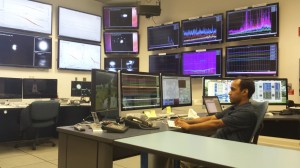OXFORD, Miss. – A team of University of Mississippi physicists involved in the creation of a groundbreaking technology designed to observe ripples in the fabric of space and time are elated that it began collecting data recently.
The Advanced Laser Interferometer Gravitational-Wave Observatory Project, created using significant contributions from UM scientists, initiated operations Sept. 18. A major upgrade from earlier LIGO detectors that operated in 2009-2010, the new Advanced LIGO detectors give scientists renewed hope of actually detecting the gravitational waves predicted in Albert Einstein’s theory of general relativity almost 100 years ago.
“Gravitational waves are emitted by violent events in the universe, such as exploding stars and colliding black holes,” said Marco Cavaglia, UM associate professor of physics and astronomy and a spokesperson for the Ole Miss LIGO Group. “These waves carry information not only about the objects that produce them, but also about the nature of gravity in extreme conditions that cannot be obtained by other astronomical tools.”
Experimental attempts to find the rare phenomenon and its incredibly tiny signal amplitudes have been going on for more than 50 years. Designed and operated by the California Institute of Technology and Massachusetts Institute of Technology, with funding from the National Science Foundation, LIGO consists of identical detectors in Livingston, Louisiana, and Hanford, Washington.
Each of the 4-kilometer L-shaped LIGO interferometers uses a laser beam split into two shafts that travel back and forth through the long arms, within tubes from which the air has been evacuated. The beams are used to monitor the distance between precisely configured mirrors. According to Einstein’s theory, the relative distance between the mirrors will change very slightly when a gravitational wave passes by.
“Although earlier LIGO runs revealed no detections, Advanced LIGO increases sensitivity, resulting in a possible thousandfold increase in observable candidate objects,” said David Reitze, the executive director of the LIGO program at Caltech.
“The first Advanced LIGO science run is taking place with interferometers that can ‘see’ events more than three times further than the initial LIGO detector,” added David Shoemaker, the MIT Advanced LIGO project leader. “So, we’ll be probing a much larger volume of space.”
UM joined the LIGO Scientific Collaboration in July 2007. Since then, researchers and students have received more than $1.8 million in NSF support to sustain LIGO’s core mission. More funding at this or higher rates are expected in the years to come.
While the scientific and engineering team at Caltech and MIT has been leading the effort to build Advanced LIGO, several groups from the international LIGO Scientific Collaboration also contributed to the design and construction of the world’s most-sensitive gravitational wave detector.
“The work performed by the UM LIGO group so far has involved the identification of unwanted noise sources in the detectors and their subsystems, an essential step for obtaining astrophysical results,” Cavaglia said. “We also developed educational and diversity initiatives, such as teacher workshops, physics and astronomy family nights, afterschool programs, interdisciplinary art and science events, and the traveling Astronomy’s New Messengers exhibits, which were first unveiled at the World Science Festival in 2009 and 2010 in New York City and have traveled the country since then.”
Katherine Dooley, UM assistant professor of physics and astronomy, worked directly with both the original and Advanced LIGO projects. She spent four years at the LIGO Livingston site, first installing new hardware to upgrade the initial LIGO detectors and then commissioning the interferometer.
“The goal of commissioning work is to create a detector with the best possible sensitivity to gravitational waves and to maximize the amount of time the interferometer is in a state in which it can collect scientific data,” Dooley said.
“My current work focuses on developing and testing new technologies that can be used to improve the sensitivity of the interferometers even further beyond that of the baseline Advanced LIGO design. This includes the use of squeezed light, a quantum optics technique that will enable us to more clearly and loudly witness the final moments of the inspiral of two neutron stars, for instance.”
Ultimately, scientists predict Advanced LIGO will be able to see 10 times as far as initial LIGO and, based on theoretical predictions, should detect many binary neutron star mergers per year.
“The improved instruments will be able to look at the last minutes of the life of pairs of massive black holes as they spiral closer together, coalesce into one larger black hole and then vibrate much like two soap bubbles becoming one,” Reitze said. “Advanced LIGO also will be able to pinpoint periodic signals from the many known pulsars that radiate in the range of 10 to 1,000 Hertz, frequencies that roughly correspond to low and high notes on an organ.
“In addition, Advanced LIGO will be used to search for the gravitational cosmic background, allowing tests of theories about the development of the universe only 10 to 35 seconds after the big bang.”
The scientists expect it will take five years to fully optimize the detector performance and achieve such design sensitivity.
“It has been a long road, and we’re very excited to resume the hunt for gravitational waves,” Reitze said.
For more on the Advanced LIGO Project, visit http://www.caltech.edu/news/advanced-ligo-begin-operations-47898#sthash.DAmQPJ1U.dpuf.
